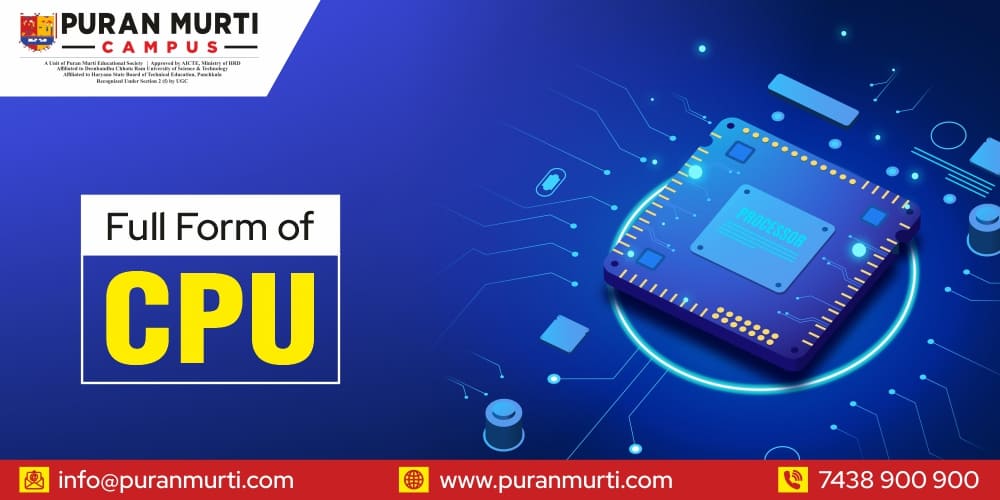What is the Full Form of CPU?
Posted on : 29 May, 2025 10:58 pm
We use computers almost every day—whether it’s for schoolwork, watching videos, playing games, or even shopping online. But have you ever stopped to wonder what goes on inside a computer that makes it all work? If you’ve heard the term CPU and weren’t sure Full Form of CPU, don’t worry—you’re not alone. Today, let’s break it down in a way that’s super easy to understand.
✅ Full Form of CPU
The full form of CPU is:
Central Processing Unit
It’s often called the brain of the computer, and that’s honestly the best way to describe it. Just like your brain controls your thoughts, movements, and decisions—the CPU controls everything your computer does.
💡 What Does a CPU Do?
Imagine you’re opening a file, typing a document, or playing a game. All those tasks go through the CPU. It’s the one processing your commands and making sure things run smoothly.
Here’s what the CPU is responsible for:
-
nhProcessing instructions from programs and apps
-
Performing calculations (maths, logic, etc.)
-
Managing data flow between the memory, storage, and other parts
-
Coordinating tasks so your computer doesn’t freeze or crash
Basically, nothing works without the CPU. It’s the central piece that connects everything and keeps your system alive.
🧠 How Does the CPU Work?
Now, don’t worry—we won’t go too technical. But here’s a basic idea:
The CPU has three main parts:
-
ALU (Arithmetic Logic Unit) – Does all the math and logic.
-
CU (Control Unit) – Directs the flow of data like a traffic controller.
-
Registers – Small storage areas that hold data temporarily for quick access.
When you click on something, the CPU quickly:
-
Understands what you want (input),
-
Processes it using ALU and CU,
-
Delivers the result (output) to your screen.
And it does this in milliseconds. Pretty amazing, right?
🧬 CPU in Daily Life: Real Examples
Still unsure how the CPU affects your everyday computer use? Here are a few examples:
-
When you open a browser – The CPU loads your browser and processes your actions (like typing a URL).
-
While gaming – The CPU calculates movement, physics, and helps render the game environment (along with the GPU).
-
While editing videos – The CPU helps cut, process effects, and export the video.
The faster the CPU, the smoother your experience.
📊 Common CPU-Related Terms You Might Hear
To help you understand even better, here are some common terms:
-
Processor – Another name for CPU.
-
Cores – Modern CPUs have multiple “mini-CPUs” (cores) for multitasking.
-
GHz (Gigahertz) – The speed of your CPU.
-
Intel & AMD – The two biggest CPU brands in the market.
🧑💻 Who Needs a Powerful CPU?
Everyone uses a CPU, but not everyone needs the most powerful one. Here’s a rough idea:
-
Students (basic tasks) → Dual-core CPU is enough
-
Office users (Word, Excel, browsing) → Quad-core CPU is ideal
-
Gamers & Designers → At least a 6-core or 8-core CPU
-
Developers, Engineers → High-performance CPUs for compiling, simulations, etc.
✍ Final Thoughts
Now that you know the full form of CPU (Central Processing Unit) and what it actually does, you’ll probably look at your computer a little differently. It’s easy to overlook, but without the CPU, your laptop or PC is just a lifeless machine.
So the next time someone asks, “What does CPU stand for?”, you won’t just know the answer—you’ll understand it too.
Whether you’re a student, tech enthusiast, or just someone curious about how computers work, knowing about the CPU is a great first step in understanding the world of tech.
Got more questions about computer parts or tech terms? Drop them in the comments or message me directly. I’d love to help out or even write a blog on your topic!
Would you like a Hindi version of this blog or want it turned into a YouTube script? Just let me know. 😊

